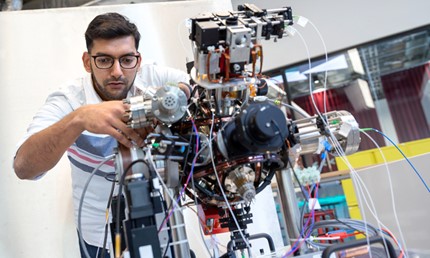QUANTUM ACCELEROMETRY
Quantum interferometry makes use of the coherence of superposition states. In contrast to light, when the interference objective is cold atomic cloud, strong coupling with environment due to large polarizability, magnetic moment and scattering cross section yields today’s highest metrological sensitivity and precision.
Global and Space Positioning
Navigation in the Dark
Once optical contacts with satellites are lost or remotely unreachable, the navigation suddenly fails. Quantum accelerometer that delivers precise absolute distance from a given initial point at a prescribed time allows pilotage in full stealth without relying on satellite-based positioning. The vessel’s location recorded with 1,000 times more precise than all existing technology means unparalleled long-term accuracy (<2km after 1 month) without external reference for recalibration.
Quantum Tech: Laser-cooled rubidium-85 atoms free fall in high vacuum while a counter-propagating Raman laser pulse equally split the atomic cloud into two quantum waves, each atom in two classical states, along an axis of measurement. A second pulse switches the atomic states, and the third pulse recombines the clouds. At the final viewport, the wavefunctions of two separate paths interfere and the populations in the two hyperfine ground states are measured. After few identical experiments, the absolute acceleration is statistical extracted and constantly monitored. A record of acceleration over time in all three axes are integrated to get instant velocity and distance from the start position.
Direct Societal Impact: Stealth aircrafts, satellite unavailability for fully submerged submarines, infrastructure-critical oil tankers, precision space navigation.
Collateral Advantages: Inertial navigation e.g., and gradiometers, research topics such as dark energy and gravitational waves.
Alternative Quantum Technology: –
Aided System: Pressure meter (depth/height), Magnetic compass (heading), Doppler velocity log (velocity), Underwater transponders (range from known position), GPS (position, velocity, orientation), Kalman Filter (state estimation)

Note: 1) Both are two-photon Raman pulses 2) All pulses are pi 3) The path for both clouds is kick IF1> => IF2>, decelerate IF2> => IF1>, kick IF1> => IF2> 4) Lasers rotate with the vessel, so the optical phase shift. This affects the closed loop area when interacting with atoms. 5) A flying mosquito in a car sense no rotation of the car but atoms in vacuum / matter-wave in vacuum will move with the glass cell.
